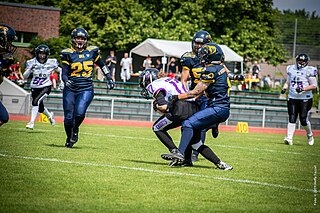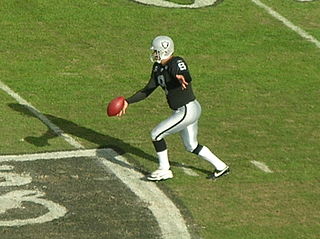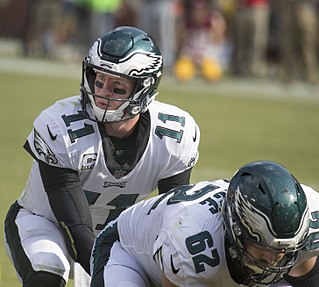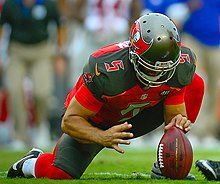A drop kick is a type of kick in various codes of football. It involves a player intentionally dropping the ball and then kicking it either 'as it rises from the first bounce' (rugby) or 'as, or immediately after, it touches the ground'.

The quarterback, colloquially known as the "signal caller", is a position in gridiron football. Quarterbacks are members of the offensive platoon and mostly line up directly behind the offensive line. In modern American football, the quarterback is usually considered the leader of the offense, and is often responsible for calling the play in the huddle. The quarterback also touches the ball on almost every offensive play, and is almost always the offensive player that throws forward passes. When the QB is tackled behind the line of scrimmage, it is called a sack.

Michael John Vanderjagt is a Canadian former football placekicker who played in the National Football League (NFL) for nine seasons, primarily with the Indianapolis Colts. He served as the Colts' placekicker from 1998 to 2005 and was a member of the Dallas Cowboys during his final NFL season in 2006. Vanderjagt also played for four seasons in the Canadian Football League (CFL), where he spent three seasons with the Toronto Argonauts and one with the Saskatchewan Roughriders.

In American football, the placekicker, or simply kicker, is the player who is responsible for the kicking duties of field goals and extra points. In most cases, the placekicker also serves as the team's kickoff specialist and occasionally in youth football, also acts as the punter.

American and Canadian football are gridiron codes of football that are very similar; both have their origins partly in rugby football, but some key differences exist between the two codes.
Strategy is a major part of American football.

A punter (P) in gridiron football is a special teams player who receives the snapped ball directly from the line of scrimmage and then punts (kicks) the football to the opposing team so as to limit any field position advantage. This generally happens on a fourth down in American football and a third down in Canadian football. Punters may also occasionally take part in fake punts in those same situations, when they throw or run the football instead of punting.

Center or Centre (C) is a position in American football. The center is the innermost lineman of the offensive line on a football team's offense. The center is also the player who passes the ball between his legs to the quarterback at the start of each play.

In gridiron football, the long snapper is a center on special teams whose duty is to snap the football over a longer distance, typically around 15 yards during punts, and 7–8 yards during field goals and conversion attempts.

In American football, a gunner, also known as a shooter, flyer, headhunter, or kamikaze, is a player on kickoffs and punts who specializes in running down the sideline very quickly in an attempt to tackle the kick or punt returner. Gunners must have several techniques in order to break away or "shed" blockers, and have good agility in order to change their running direction quickly. Gunners on the punt team also must be able to block or catch.
A trick play, also known as a gadget play, gimmick play or trickeration, is a play in gridiron football that uses deception and unorthodox tactics to fool the opposing team. A trick play is often risky, offering the potential for a large gain or a touchdown if it is successful, but with the chance of a significant loss of yards or a turnover if not. Trick plays are rarely used not only because of the riskiness, but also to maintain the element of surprise for when they are used.

In American football, the specific role that a player takes on the field is referred to as their "position". Under the modern rules of American football, both teams are allowed 11 players on the field at one time and have "unlimited free substitutions", meaning that they may change any number of players during any "dead ball" situation. This has resulted in the development of three task-specific "platoons" of players within any single team: the offense, the defense, and the so-called 'special teams'. Within these three separate "platoons", various positions exist depending on the jobs that the players are doing.
The Swinging Gate, sometimes referred to as the muddle huddle, is an unorthodox set-piece play in American football, executed in either the offensive or special-teams sections of play. It is unusual in that the offensive line, with the exception of the center, will line up to one side of the field, leaving the quarterback and running back unprotected on the other. Its goal is to disconcert a defensive front in order to allow a quick screen pass to a wide receiver with six blockers, or to allow a short run by the running back. Surprise is the main goal of the play, and it is not typically run outside of short-yardage situations.

A field goal (FG) is a means of scoring in gridiron football. To score a field goal, the team in possession of the ball must place kick, or drop kick, the ball through the goal, i.e., between the uprights and over the crossbar. The entire ball must pass through the vertical plane of the goal, which is the area above the crossbar and between the uprights or, if above the uprights, between their outside edges. American football requires that a field goal must only come during a play from scrimmage while Canadian football retains open field kicks and thus field goals may be scored at any time from anywhere on the field and by any player. The vast majority of field goals, in both codes, are placekicked. Drop-kicked field goals were common in the early days of gridiron football but are almost never attempted in modern times. A field goal may also be scored through a fair catch kick, but this is also extremely rare. In most leagues, a successful field goal awards three points.
A kickoff specialist is a special teams position in gridiron football. They are responsible for kicking the ball in the kickoff. These players tend to have a strong leg, often capable of making touchbacks, and capable of keeping a ball in the bounds of the field of play but do not have the accuracy or technique required to be a full-time placekicker or punter. For most teams, the placekicker is the kickoff specialist.
The following terms are used in American football, both conventional and indoor. Some of these terms are also in use in Canadian football; for a list of terms unique to that code, see Glossary of Canadian football.
Field goal range is the part of the field in American football where there is a good chance that a field goal attempt will be successful.
A fake field goal is a trick play in American football. Simply, it involves a running or passing play done out of a kick formation. Usually the holder will throw or run. Less frequently, the placekicker, who virtually never handles the ball in an American football game, will serve as the passer or rusher on a fake field goal.
A kicking specialist or kick specialist, sometimes referred to as a kicker, especially when referring to a placekicker, is a player on gridiron football special teams who performs punts, kickoffs, field goals and/or point after touchdowns. The special teams counterpart of a kicking specialist is a return specialist.

Brett Maher is an American football placekicker for the Los Angeles Rams of the National Football League (NFL). He played college football at Nebraska and was signed by the New York Jets of the National Football League (NFL) as an undrafted free agent in 2013. Maher has also been a member of the Dallas Cowboys, Winnipeg Blue Bombers, Ottawa Redblacks, Hamilton Tiger-Cats, Cleveland Browns, Washington Commanders, Houston Texans, Arizona Cardinals, New Orleans Saints, Denver Broncos, and Los Angeles Rams.














